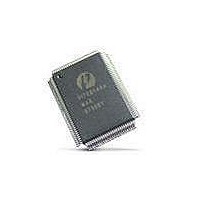PI7C8140AMAE Pericom Semiconductor, PI7C8140AMAE Datasheet - Page 39

PI7C8140AMAE
Manufacturer Part Number
PI7C8140AMAE
Description
IC PCI-PCI BRIDGE 2PORT 128-QFP
Manufacturer
Pericom Semiconductor
Datasheet
1.PI7C8140AMAE.pdf
(82 pages)
Specifications of PI7C8140AMAE
Applications
*
Interface
*
Voltage - Supply
*
Package / Case
128-QFP
Mounting Type
Surface Mount
Maximum Operating Temperature
+ 85 C
Minimum Operating Temperature
0 C
Mounting Style
SMD/SMT
Operating Supply Voltage
3 V to 3.6 V
Supply Current (max)
230 mA
Lead Free Status / RoHS Status
Lead free / RoHS Compliant
Available stocks
Company
Part Number
Manufacturer
Quantity
Price
Company:
Part Number:
PI7C8140AMAE
Manufacturer:
Pericom
Quantity:
135
Company:
Part Number:
PI7C8140AMAE
Manufacturer:
SONY
Quantity:
469
Part Number:
PI7C8140AMAE
Manufacturer:
PERICOM
Quantity:
20 000
07-0067
4.2
4.3
Delayed read completion transactions, comprised of all memory read, I/O read, & configuration
read transactions.
Delayed read completion transactions complete on the target bus, and the read data is queued in the read
data buffers. A delayed read completion transaction proceeds in the direction opposite that of the
original delayed read request; that is, a delayed read completion transaction proceeds from the target
bus to the initiator bus.
The bridge does not combine or merge write transactions:
GENERAL ORDERING GUIDELINES
Independent transactions on primary and secondary buses have a relationship only when those
transactions cross the bridge.
The following general ordering guidelines govern transactions crossing the bridge:
ORDERING RULES
Table 4-1 shows the ordering relationships of all the transactions and refers by number to the ordering
rules that follow.
The bridge does not combine separate write transactions into a single write transaction—this
optimization is best implemented in the originating master.
The bridge does not merge bytes on separate masked write transactions to the same DWORD
address—this optimization is also best implemented in the originating master.
The bridge does not collapse sequential write transactions to the same address into a single write
transaction—the PCI Local Bus Specification does not permit this combining of transactions.
The ordering relationship of a transaction with respect to other transactions is determined when the
transaction completes, that is, when a transaction ends with a termination other than target retry.
Requests terminated with target retry can be accepted and completed in any order with respect to
other transactions that have been terminated with target retry. If the order of completion of delayed
requests is important, the initiator should not start a second delayed transaction until the first one
has been completed. If more than one delayed transaction is initiated, the initiator should repeat all
delayed transaction requests, using some fairness algorithm. Repeating a delayed transaction cannot
be contingent on completion of another delayed transaction. Otherwise, a deadlock can occur.
Write transactions flowing in one direction have no ordering requirements with respect to write
transactions flowing in the other direction. The bridge can accept posted write transactions on both
interfaces at the same time, as well as initiate posted write transactions on both interfaces at the
same time.
The acceptance of a posted memory write transaction as a target can never be contingent on the
completion of a non-locked, non-posted transaction as a master. This is true for the bridge and must
also be true for other bus agents. Otherwise, a deadlock can occur.
The bridge accepts posted write transactions, regardless of the state of completion of any delayed
transactions being forwarded across the bridge.
Page 39 of 82
2-PORT PCI-TO-PCI BRIDGE
March 20, 2007 – Revision 1.01
PI7C8140A











